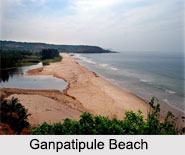 Ganpatipule Beach is a small beach town, which is located at Ganpatipule town in Ratnagiri district on the Konkan coast of Maharashtra. The beach often attracts many tourists with its tranquil ambience, clear water and white sand. Ganpatipule Beach town is one of the most visited places of Maharashtra, which is partially popular for the Ganapati Temple in this region as well.
Ganpatipule Beach is a small beach town, which is located at Ganpatipule town in Ratnagiri district on the Konkan coast of Maharashtra. The beach often attracts many tourists with its tranquil ambience, clear water and white sand. Ganpatipule Beach town is one of the most visited places of Maharashtra, which is partially popular for the Ganapati Temple in this region as well.
Etymology of Ganpatipule Beach
As per legends, the Hindu God, Lord Ganapati, taking offence by a remark made by a native lady, moved to Pule (a few km ahead of the town) from his original abode of Gule. Thus the region was named Ganpati-pule. 400 years old Ganapati image at Ganpatipule is said to have sprung up from the earth. This deity of the Ganapati Temple in this area faces the West side, so as to guard the western gates, unlike deities in other Indian temples who face the east side. The temple is at the base of a hill, and pilgrims walk around (Pradakshina) the hill as a symbol of respect.
Other Attractions of Ganpatipule Beach
Apart from the Ganpatipule Beach and the Temple of Swayambhu Ganesh, Ganpatipule is also rich in flora, including Mangroves and Coconut palms.
Visiting Information to Ganpatipule Beach
Ganpatipule Beach can be reached by rail, road and air. Nearest airport to this area is Lohegaon Airport (167 km) and Dabolim Airport (218 km). Nearest railway station is Ratnagiri Station. This place can also be reached by roads either via Hatkhamba or via Nivali.
This article is a stub. You can enrich by adding more information to it. Send your Write Up to content@indianetzone.com



















